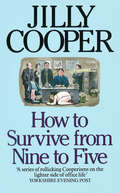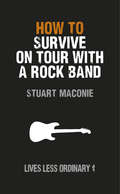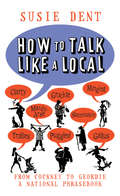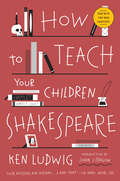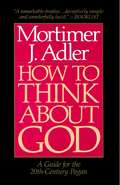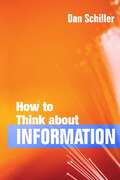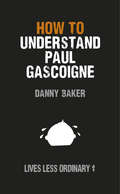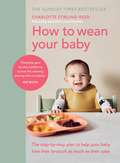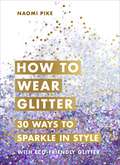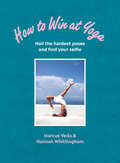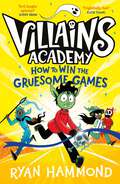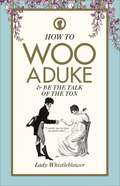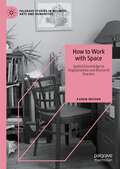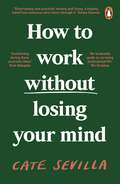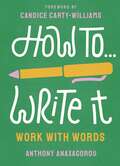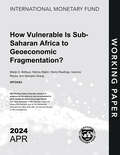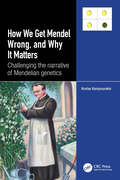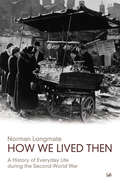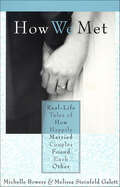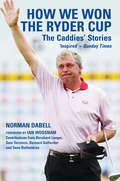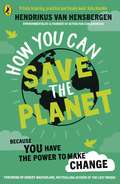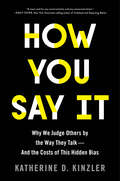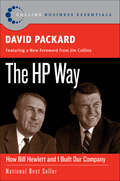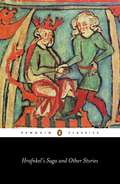- Table View
- List View
How To Survive From Nine To Five
by Jilly Cooper OBEJilly Cooper's witty thumbnail sketch of office life - part valentine, part poison pen letter - offers a vivid evocation of the world in which many of us spend a large part of our lives. There will be few office workers, whether they are bosses, sekketries or office crones, who do not recognize the Machiavellian politics and the lunacies she describes. The topics covered by this survival guide range from 'The Hierarchy' and 'Office Happenings' to 'Extra-mural Activities' and 'The Firing Squad'. Early in her career the author worked in an office and she has many friends, including a husband, who still do: but it will come as no surprise to readers of this classic volume to learn that since its publication she has been self-employed.
How to Talk Like a Local: A National Phrasebook from the author of Word Perfect
by Susie Dent'Susie Dent is a national treasure' RICHARD OSMAN'Susie Dent is a one-off. She breathes life and fun into words and language' PAM AYRES__________________________________________Would you be bewildered if someone described you as radgy?Do you know how to recognise a tittamatorter?And would you understand if someone called you a culchie?How to Talk Like a Local gathers together hundreds of words from all over the country and digs down to uncover their origins. From dardledumdue, which means daydreamer in East Anglia, through forkin robbins, the Yorkshire term for earwigs, to clemt, a Lancashire word that means hungry, it investigates an astonishingly rich variety of regional expressions, and provides a fascinating insight into the history of the English language.If you're intrigued by colourful words and phrases, if you're interested in how English is really spoken, or if you simply want to find out a bit more about the development of our language, How to Talk Like a Local is irresistible - and enlightening - reading.__________________________________________________'Nobody on earth knows more about the English language than Susie Dent and nobody writes about it more entertainingly' GYLES BRANDRETH'It's an interesting and, at times, hilarious read. One for word-lovers' THE SUN
How to Teach Your Children Shakespeare
by Ken LudwigA foolproof, enormously fun method of teaching your children the classic works of William Shakespeare, by a Tony Award–winning playwright—now featuring two new chapters &“You and your children will be transformed by the magic and mystery of Shakespeare and his stories in an instant.&”—Sir Derek Jacobi, CBE Winner of the Falstaff Award for Best Shakespeare BookTo know some Shakespeare provides a head start in life. His plays are among the great bedrocks of Western civilization and contain the finest writing of the past 450 years. Many of the best novels, plays, poems, and films in the English language produced since Shakespeare&’s death in 1616—from Pride and Prejudice to The Godfather—are heavily influenced by Shakespeare&’s stories, characters, language, and themes. In How to Teach Your Children Shakespeare, acclaimed playwright Ken Ludwig provides the tools you need to inspire an understanding, and a love, of Shakespeare&’s works in your children, and to have fun together along the way.Ken Ludwig devised his friendly, easy-to-master methods while teaching his own children. Beginning with memorizing short passages from the plays, his technique then instills children with cultural references they will utilize for years to come. Ludwig&’s approach includes understanding of the time period and implications of Shakespeare&’s diction as well as the invaluable lessons behind his words and stories. Colorfully incorporating the history of Shakespearean theater and society, How to Teach Your Children Shakespeare guides readers on an informed and adventurous journey through the world in which the Bard wrote.This book&’s simple process allows anyone to impart to children the wisdom of plays like A Midsummer Night&’s Dream, Twelfth Night, Macbeth, and Romeo and Juliet. And there&’s fun to be had throughout. Shakespeare novices and experts and readers of all ages will each find something delightfully irresistible in How to Teach Your Children Shakespeare.
How to Think About God: A Guide for the 20th-Century Pagan
by Mortimer J. AdlerDr. Adler, in his discussion, extends and modernizes the argument for the existence of God developed by Aristotle and Aquinas. Without relying on faith, mysticism, or science (none of which, according to Dr. Adler, can prove or disprove the existence of God), he uses a rationalist argument to lead the reader to a point where he or she can see that the existence of God is not necessarily dependent upon a suspension of disbelief. Dr. Adler provides a nondogmatic exposition of the principles behind the belief that God, or some other supernatural cause, has to exist in some form. Through concise and lucid arguments, Dr. Adler shapes a highly emotional and often erratic conception of God into a credible and understandable concept for the lay person.
How to Think about Information
by Dan SchillerIt is common wisdom that the U.S. economy has adapted to losses in its manufacturing base because of the booming information sector, with high-paying jobs for everything from wireless networks to video games. We are told we live in the Information Age, in which communications networks and media and information services drive the larger economy. While the Information Age may have looked sunny in the beginning, as it has developed it looks increasingly ominous: its economy and benefits grow more and more centralized--and in the United States, it has become less and less subject to democratic oversight. Corporations around the world have identified the value of information and are now seeking to control its production, transmission, and consumption. In How to Think about Information, Dan Schiller explores the ways information has been increasingly commodified as a result and how it both resembles and differs from other commodities. Through a linked series of theoretical, historical, and contemporary studies, Schiller reveals this commodification as both dynamic and expansionary, but also deeply conflicted and uncertain. He examines the transformative political and economic changes occurring throughout the informational realm and analyzes key dimensions of the process, including the buildup of new technological platforms, the growth of a transnationalizing culture industry, and the role played by China as it reinserts itself into an informationalized capitalism.
How to Understand Paul Gascoigne: Lives Less Ordinary
by Danny Baker Danny KellyThe Lives Less Ordinary series brings you the most exciting, adventurous and entertaining true-life writing that is out there, for men who are time-poor but want the best. Lives Less Ordinary drops you into extreme first-hand accounts of human experience, whether that's the adrenaline-pumping heights of professional sport, the brutality of the modern battlefield, the casual violence of the criminal world, the mind-blowing frontiers of science, or the excesses of rock 'n' roll, high finance and Hollywood. Lives Less Ordinary also brings you some of the finest comic voices around, on every subject from toilet etiquette to Paul Gascoigne.Paul Gascoigne is a legend, both on and off the pitch, and a hero to a generation of football fans. The man who, during Italia '90, made it OK to cry, and made the English fall in love with football all over again. Despite endless books about him he is still an enigma to most, so who better than his closest confident (and national institution himself), Danny Baker, to explain what truly makes him tick.This digital bite has been extracted from Danny Baker and Danny Kelly's brilliant book Classic Football Debates.
How to Wean Your Baby: The step-by-step plan to help your baby love their broccoli as much as their cake
by Charlotte Stirling-ReedTHE SUNDAY TIMES BESTSELLER'Charlotte gave me the confidence and knowledge to love every single step of the weaning journey' Joe Wicks'Charlotte really is a font of knowledge when it comes to weaning.'Jools Oliver'We've loved Charlotte's approach to weaning. Skye loves her food and we are so grateful for that!'Ella MillsThe easy weaning plan to ensure your baby becomes a happy and adventurous little eater.In this beautiful, full-colour book, expert nutritionist Charlotte Stirling-Reed reveals her renowned method that has helped thousands of parents wean their babies confidently.Based on a vegetable first approach, the perfect way to develop healthy eating habits and to tackle fussy eating before it begins, you'll be hand-held through the first 30 days of weaning as well as given lots of delicious recipes all the family can enjoy.Packed with tried and tested tips, as well as the latest evidence-based guidance, How to Wean Your Baby will fully equip and empower you to take this exciting next step.
How to Wear Glitter: 30 Ways to Sparkle in Style
by Naomi PikeLive life with a little more sparkle. This is your one-stop guide to glitter and how to wear it. Includes only the best biodegradable and ethical brands (please glitter responsibly!).Features 30 gorgeous step-by-step looks from all-sparkle lips to intricate eye make-up, glitter braids and beards, to full-on body art or a perfectly simple glitter lash line.Halloween, Christmas or festival season just isn't the same without a little sparkle and shimmer. Also includes glitter inspiration from the runway to Instagram, your basic eco-glitter beauty kit, fashion and accessories to complete the look, sparkling stockists and top tips from the experts, including make-up artists, drag queens, celebs, stylists and fashion designers.Grab your glitter, because you deserve to shine!
How to Win at Yoga: Nail the hardest poses and find your selfie
by Marcus Veda Hannah WhittinghamGet in to the hardest poses and get out aliveFive years ago your average yoga class contained a few down dogs, a standing tree and a cushion for meditation. Today, it is becoming increasingly clear that many wish to gain enlightenment through sticking their foot behind their head. Preferably in a handstand, ideally in the splits. And then post it on Instagram.Whether enlightenment is achievable through a one-armed handstand or not, crowded yoga studios are not the ideal places to start nailing risky moves, so this handy guide is here to demystify the big poses in full technicolour. Most importantly, you will learn how to take impressive pictures of your journey to enlightenment, so you can win at yoga, publicly.From sunset splits to backbends in Bali, packed with drills for strength and flexibility and tips for costume and hair, How to Win at Yoga makes those apparently impossible yoga poses possible, and look great on the 'gram.
How to Win the Gruesome Games (Villains Academy #3)
by Ryan HammondBeing BAD has never felt so GOOD! The third book in the villainously funny, highly illustrated young middle-grade series from author-illustrator Ryan Hammond. For fans of Amelia Fang, Dog Man and Grimwood. Check out the complete series – Villains Academy and Villains Academy: How to Steal a Dragon. &‘Heart-warming and hilarious – Villains Academy is a spookalicious treat, set to terrify every other book on your shelf.&’ Jack Meggitt-Phillips, author of The Beast and the Bethany &‘An absolute HOOT! Evil laughs aplenty!&’ Sophy Henn, author and illustrator of the Pizazz series Once a year the five original founders of Villains Academy rise from their graves in honour of the Gruesome Games – a school sports day unlike any other, where the aim is to prank and cheat your way to the finish line. Werewolf Bram and his friends the Cereal Killers are determined to win so their names can be written in the Book of Bad, a record of the most wicked villains to grace the school. But as the games become harder and the pranks get out of hand, are Bram and his friends bad enough to go down as the most victorious villains in history? PRAISE FOR VILLAINS ACADEMY: &‘A charmingly villainous adventure about friendship, school and unspeakable evil.&’ Louie Stowell, author of Loki: A Bad God&’s Guide to Being Good &‘Criminally fun!&’ Danny Wallace, author of The Day the Screens Went Blank &‘Frightfully fun – Villains Academy had me cackling from the very first page!&’ Katie Tsang, co-author of the Dragon Realm series &‘I loved the spookily funny Villains Academy. It's a work of (evil) genius!&’ Jenny McLachlan, author of The Land of Roar &‘A joyful hug of a book with genuine warmth and heart.&’ Hannah Gold, author of The Last Bear &‘A delightfully fun adventure with real heart and humour.&’ Benjamin Dean, author of Me, My Dad and the End of the Rainbow &‘Immersive, funny, and with a cast of scarily loveable characters, Villains Academy made me feel like I was IN the book!&’ Mel Taylor-Bessent, author of The Christmas Carrolls &‘A fabulously funny adventure. I want to enrol in Villains Academy!&’ Nick Sheridan, author of The Case of the Runaway Brain &‘Wickedly funny and full of quirky yet loveable characters.&’ Iona Rangeley, author of Einstein the Penguin &‘This is a brilliant, bonkers work packed with top-notch illustration.&’ Jack Noel, author and illustrator of the Comic Classics series &‘Full of wonderful characters, Villains Academy is such a FUN read!&’ Rikin Parekh, illustrator of The Worst Class in the World series
How to Woo a Duke: & be the talk of the ton
by Lady WhistleblowerShall we promenade? Dear Reader, Welcome to the definitive guide to navigating the social season. Learn about etiquette in all its forms. Within these abundant leaves you will be gifted with all the instruction and patronage necessary to take your place in society. Sort your Dandies from your Rakes, your Merry Andrews from your Bucks. All of the menagerie of beau monde's are contained within. So read on dearest reader and bury oneself in the pool of knowledge that will equip oneself to Woo a Duke and become the talk of the ton.Yours sincerelyLady Whistleblower
How to Work with Space: Spatial Knowledge in Organizations and Research Practice (Palgrave Studies in Business, Arts and Humanities)
by Karen MesserThis book is an exploration of the entangled spatial relationships with and within organizations and research practice. Situating our environment as an active participant in the outcomes of day-to-day living heightens the role space can have as a co-creator of experience, behaviour and emotion. Physical environments tend to fade into the background, becoming an unseen, untended, accompaniment in our journey. However, through active attunement and deep noticing, spatial details arise through our bodies, senses, conversations and physical encounters. As the nature of work continues to evolve, understanding and shifting our relationship with the work environment broadens the scope of how space and work are engaged and performed. This thoughtful book will be of great interest to academics and students of organisational studies, as well as those involved in interdisciplinary research across geography, anthropology and the social sciences.
How to Work Without Losing Your Mind
by Cate Sevilla'Genuinely empowering' Daisy Buchanan'An invaluable guide to surviving professional life' Viv Groskop'Comforting during these uncertain times' Yomi AdegokeAward-winning journalist and editor-in-chief Cate Sevilla has survived the messy, stressy and sometimes bizarre world of work - just.In How to Work Without Losing Your Mind, she gives an unflinchingly honest account of the bad bosses, the time spent crying in work loos, the hell and humiliation of her working life but, most importantly, she reveals the solid self-belief, the sage advice and the hard-won lessons that got her through.Filled with humour, wit and supportive words, this book is your essential guide to fixing your relationship with your work. Press it into the hands of every womxn who is sinking in a toxic work environment, battling burnout, recovering from redundancy or trying to find the right career fit. 'Entertaining and practical; moving and funny; a helping hand from someone who's been through it' Emma Gannon, Sunday Times bestselling author
How To Write It: Work With Words (Merky How To #1)
by Anthony Anaxagorou_________________________How to Write It: Tell Your StoryThis book is a masterclass in the craft of writing and poetry from one of Britain's most celebrated poets and educators, T.S. Eliot Prize nominee Anthony Anaxagorou.Taking readers on a personal journey through his early life and school years, through to his relationship with literature, education poetry and writing, this book is filled with tips, anecdotes and publishing advice for anyone interested in getting their work seen. From Anthony's first slam win to the evolving British poetry scene, this book will provoke readers into thinking about their writing more carefully - be it a poem, short story or novel - and help them finally get their book out into the world.This book is essential reading for taking your work to the next level, and is introduced with an inspirational foreword by Sunday Times bestselling author, Candice Carty-Williams. _________________________'This brilliant little book [...] a guide to writing practical and theoretical' Radio 4, 'Start The Week'_________________________Designed to inspire and encourage readers to unlock their potential and provoke change, the How To series offers a new model in publishing, helping to break down knowledge barriers and uplift the next generation. Creatively presented and packed with clear, step-by-step, practical advice, this series is essential reading for anyone seeking guidance to thrive in the modern world. Curate your bookshelf with these collectable titles.
How Vulnerable is Sub-Saharan Africa to Geoeconomic Fragmentation?
by ZhangA report from the International Monetary Fund.
How we Get Mendel Wrong, and Why it Matters: Challenging the narrative of Mendelian genetics
by Kostas KampourakisThis book illustrates that the stereotypical representations of Gregor Mendel and his work misrepresent his findings and their historical context. The author sets the historical record straight and provides scientists with a reference guide to the respective scholarship in the early history of genetics. The overarching argument is twofold: on the one hand, that we had better avoid naïve hero-worshipping and understand each historical figure, Mendel in particular, by placing them in the actual sociocultural context in which they lived and worked; on the other hand, that we had better refrain from teaching in schools the naive Mendelian genetics that provided the presumed “scientific” basis for eugenics.Key Features Corrects the distorting stereotypical representations of Mendelian genetics and provides an authentic picture of how science is done, focusing on Gregor Mendel and his actual contributions to science Explains how the oversimplifications of Mendelian genetics were exploited by ideologues to provide the presumed “scientific” basis for eugenics Proposes a shift in school education from teaching how the science of genetics is done using model systems to teaching the complexities of development through which heredity is materialized
How We Lived Then: History of Everyday Life During the Second World War, A
by Norman LongmateAlthough nearly 90% of the population of Great Britain remained civilians throughout the war, or for a large part of it, their story has so far largely gone untold. In contrast with the thousands of books on military operations, barely any have concerned themselves with the individual's experience. The problems of the ordinary family are barely ever mentioned - food rationing, clothes rationing, the black-out and air raids get little space, and everyday shortages almost none at all. This book is an attempt to redress the balance; to tell the civilian's story largely through their own recollections and in their own words.
How We Met: Real-Life Tales of How Happily Married Couples Found Each Other
by Michelle Bowers Melissa Steinfeld GalettFor everyone who loves a real-life happy ending, here are forty-five funny, romantic, and above all true tales of modern coupling. In their own words, men and women recount the surprising and serendipitous ways they came together, from jury duty encounters and sidewalk pickup lines to dramatic stories of dogged determination that paid off big in the end. For anyone who's carried a torch for a colleague or friend, looked for love on-line, or wondered if it's really true that love comes when you least expect it, How We Met offers insights into that mysterious process of finding The One. For those who've already said "I do," the book offers a rare peek into the lives of other married couples, and how they found each other.
How We Won the Ryder Cup: The Caddies' Stories
by Norman DabellThe Ryder Cup battle between Europe and the USA is one of the biggest events in the golfing calendar and in 2006, the former underdogs showed they are now the dominant force in the biennial matches. It was another marvellous example of teamwork, and the caddies have played no small part in Europe overcoming the odds. The players hit the shots; their trusty caddies share the hopes, the glory and, occasionally, the misery.What was it like being beside Sam Torrance when he holed the winning putt and shed his tears on that historic moment at The Belfry in 1985? Fast forward to 2006 and a highly emotional appearance by Darren Clarke. What was it like being by his side? What was the story behind Colin Montgomerie's right-hand-man returning to his bag to help lay to rest the ghost of 1999? How do you cope when Seve Ballesteros is in full cry against the 'old enemy', especially when you are an American yourself? In 1991, a spike mark cost Europe the tournament, but what really happened behind the ropes? Who knew his man had had a vision he would beat Tiger Woods in 1997 - and saw it come true? What was it like witnessing those awful scenes at Brookline up close and personal in 1999? Who knew exactly which line to take when Paul McGinley sank his memorable winning putt in 2002?How We Won the Ryder Cup covers all the drama that has unfolded in the competition over the years and includes the action from the 2006 tournament at The K Club, County Kildare in Ireland, which saw Europe storm to a third successive victory.
How You Can Save the Planet
by Hendrikus van Hensbergen*Foreword by Robert Macfarlane, bestselling author of The Lost Words.*If you're worried about climate change, this book is an essential and reassuring read.We often feel like we don't have the power to make real change.But our small changes can add up to something BIG. Packed with reassuring step by step actions and easy to follow DIY activities, How You Can Save The Planet is the perfect gift for young activists who want to make a difference.With simple explanations, practical tips and stories from children across the world, this guide is ideal for young people who are worried about climate change and want to help our planet!Crafted by Hendrikus van Hensbergen, whose work is featured on BBC Bitesize[JP2] , this inspiring read is perfect for children at KS2. 'Every young person in the country should be given this book' Sir Tim Smit, Founder of The Eden Project'It's enlightening, inspiring and empowering' Kate Humble, TV presenter'Wonderfully informative, fun and practical [. . .] A great source of inspiration' The Rich Brothers, TV presenters
How You Say It: Why We Judge Others by the Way They Talk—and the Costs of This Hidden Bias
by Katherine D. KinzlerFrom &“one of the most brilliant young psychologists of her generation&” (Paul Bloom), a groundbreaking examination of how speech causes some of our deepest social divides—and how it can help us overcome them We gravitate toward people like us; it&’s human nature. Race, class, and gender shape our social identities, and thus who we perceive as &“like us&” or &“not like us.&” But one overlooked factor can be even more powerful: the way we speak. As the pioneering psychologist Katherine Kinzler reveals in How You Say It, the way we talk is central to our social identity because our speech largely reflects the voices we heard as children. We can change how we speak to some extent, whether by &“code-switching&” between dialects or by learning a new language; over time, our speech even changes to reflect our evolving social identity and aspirations. But for the most part, we are forever marked by our native tongue—and are hardwired to prejudge others by theirs, often with serious consequences. Someone&’s accent alone can determine the economic opportunity or discrimination they encounter in life, making speech one of the most urgent social-justice issues of our day. Our linguistic differences present challenges, Kinzler shows, but they also can be a force for good. Humans can benefit from being exposed to multiple languages—a paradox that should inspire us to master this ancient source of tribalism and rethink the role that speech plays in our society.
The HP Way: How Bill Hewlett and I Built Our Company (Collins Business Essentials)
by David PackardIn the fall of 1930, David Packard left his hometown of Pueblo, Colorado, to enroll at Stanford University, where he befriended another freshman, Bill Hewlett. After graduation, Hewlett and Packard decided to throw their lots in together. They tossed a coin to decide whose name should go first on the notice of incorporation, then cast about in search of products to sell.Today, the one-car garage in Palo Alto that housed their first workshop is a California historic landmark: the birthplace of Silicon Valley. And Hewlett-Packard has produced thousands of innovative products for millions of customers throughout the world. Their little company employs 98,400 people and boasts constantly increasing sales that reached $25 billion in 1994.While there are many successful companies, there is only one Hewlett-Packard, because from the very beginning, Hewlett and Packard had a way of doing things that was contrary to the prevailing management strategies. In defining the objectives for their company, Packard and Hewlett wanted more than profits, revenue growth and a constant stream of new, happy customers.Hewlett-Packard's success owes a great deal to many factors, including openness to change, an unrelenting will to win, the virtue of sustained hard work and a company-wide commitment to community involvement. As a result, HP now is universally acclaimed as the world's most admired technology company; its wildly successful approach to business has been immortalized as The HP Way.In this book, David Packard tells the simple yet extraordinary story of his life's work and of the truly exceptional company that he and Bill Hewlett started in a garage 55 years ago.
Hrafnkel's Saga and Other Icelandic Stories
by AnonymousWritten around the thirteenth century AD by Icelandic monks, the seven tales collected here offer a combination of pagan elements tightly woven into the pattern of Christian ethics. They take as their subjects figures who are heroic, but do not fit into the mould of traditional heroes. Some stories concern characters in Iceland - among them Hrafknel's Saga, in which a poor man's son is murdered by his powerful neighbour, and Thorstein the Staff-Struck, which describes an ageing warrior's struggle to settle into a peaceful rural community. Others focus on the adventures of Icelanders abroad, including the compelling Audun's Story, which depicts a farmhand's pilgrimage to Rome. These fascinating tales deal with powerful human emotions, suffering and dignity at a time of profound transition, when traditional ideals were gradually yielding to a more peaceful pastoral lifestyle.
Huckleberry Finnchi Sahasa: हकलबेरी फिनची साहसं
by Mark Twainअर्नेस्ट हेमिंग्वेंपासून अनेक दिग्गजांना भावलेली ही कादंबरी. आई नसलेला, दारुड्या बापापासून पळणारा उनाड पोरगा हक फिनची ही गोष्ट. हक कायम जगाचा अदमास बांधत राहतो. निसर्गाकडे निर्मळपणे बघतो, लोकांकडे बेरक्या नजरेनं पाहातो, त्या-त्या वेळचे सामाजिक पूर्वग्रह त्याच्याही मनात आहेतच, पण या सगळ्यासकट एक गुण-दोष असलेला तरुण पोरगा म्हणून तो वाचकांपुढं उभा राहतो.
